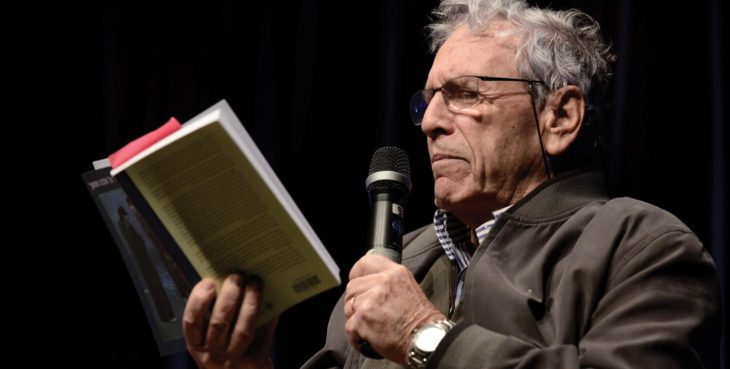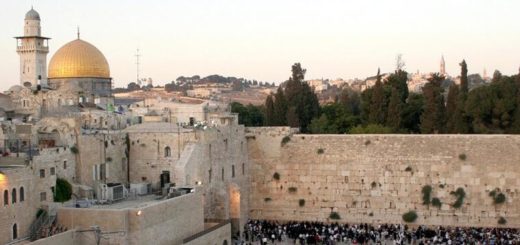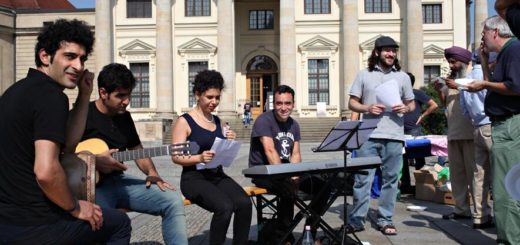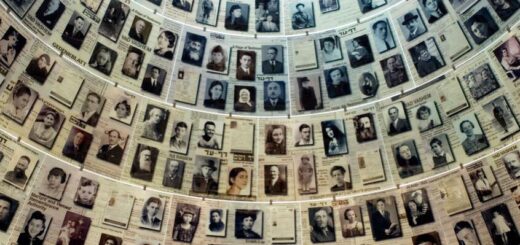Literature of Israel
Before the end of the 19th century, Eliezer Ben-Yehuda (1858–1922) had recreated Hebrew as a spoken language and developed Palestinian journalism. Some writers emerged in the 1890s, including the romantic Ze’ev (Wolf) Jawitz (1847–1924) and the more realistic Moshe Smilansky (1874–1953). But only after 1905 did Hebrew literature develop in Palestine seriously. Among the immigrants in the period 1904–1914 were Samuel Josef Agnon (1888–1970), Josef Chajim Brenner (1881–1929), Zewi Schatz (1890–1921), Devorah Baron (1887–1956), Asher Barash (1889–1952), and lyrikerneRahel Bluwstein (1890–1931) and Jacob Steinberg (1887–1947), besides David Shimoni (1886–1956) and Jacob Fichman (1881–1958), who, like Agnon and Shlomo Zemach, returned to Europe after a few years, and first settled in Palestine after 1920. Steinberg also wrote a number of novels with motifs from Ukraine.
The time until 1948
The aforementioned authors had their roots in Eastern Europe and built on European literary traditions. Some continued to write about the Jews in the country they came from, others about the pioneers’ efforts in the new homeland and about disillusioned immigrants. The Dostoevsky- influenced Brenner had started his career in Russia. He often portrayed neurotic intellectualswho were unable to free themselves from society. Dark moods also characterized other stories from Palestine. The authors who emerged during the term of office in the years 1917–1948 were also substantial immigrants. For this poet generation, the country came into focus more. Well, the disappointment of life there could appear, but essentially the deep understanding of the value of the new community they helped build. It was a rich period for the lyrics. In 1924, Chajim Nachman Bialik (1873-1934) settled in Palestine. He had long been regarded as a national poet. In 1931 came Saul Tchernichowsky (1875–1943) and in 1951 the famous poet Zalman Schneour (1887–1959).
Leading younger lyricists during the term were Uri Zvi Greenberg (1891–1981), Abraham Shlonsky (1900–1973), Nathan Alterman (1910–1970), and Lea Goldberg (1911–1970); the latter two were members of the modernist group formed by Shlonsky. He advocated for individualistic poetry and expressed his generation’s lead over modern, secularized urban life. He contrasts the protected world of childhood with the conflict the pioneer experiences between dream and hard reality. Both the influence of symbolism and surrealism can be traced in his poetry. Alterman expanded Shlonsky’s rhythmic experiments and his poems carry the features of the ballad. He was of great importance to the younger generation.
Lea Goldberg is influenced by acmeism and German symbolists. Her prose literature includes books for children and plays. Among other things, she translated Peer Gynt into Hebrew. Greenberg was politically engaged, had a religious outlook on Zionism and the particular tasks and destiny of the Jewish people. The style was often characterized by Bible, Kabbalah and other Hebrew literature. Before settling in Palestine in 1924, he used Yiddish in part. Also Shin Shalom belongs to this generation of poets, his Diary in Galilee (Norwegian translation in 1953) reproduces a landscape full of tranquility and poetry.
Realistic prose presents Yosef Aricha (born in Ukraine in 1907, moved to Palestine in 1925) in novels and short stories about life in Palestine and in the diaspora. The leading prose writer of the era next to Agnon was Chajim Hazaz (1898–1973, born in Kiev province, moved to Palestine in 1931). His earliest books are about Ukrainian Judaism during the Revolution, and after 1931, about the pioneers of Palestine and the Yemenite Jews. Jewish redemption in the form of messianism and Zionism occupies him. Other prominent prose writers during the term are Devora Baron, Asher Barash and Yehuda Burla (1886–1969). The latter, whose family had lived in Palestine from the 18th century, derived the motif in his novels and short stories from Oriental-Jewish communities. He was interested in Arabic. In his poetry he was European and American oriented.
The time after 1948
The author generations that characterize the poetry after the establishment of the State of Israel count substantially Native Israelis and immigrants who came to the country as children. The so-called Palmach generation, which in its poetry was concerned with and engaged in the liberation war in the years 1948-1949, also counts many representatives for the following two decades. The subject of Eastern Europe and the idealization of Zionism give way to greater realism, including national independence. The relationship with the Palestinian Arabs gradually occupies several writers. The writers of the 1960s and, to some extent, the 1970s, are more critical of past ideologies and of social development. They reject the oblique security of former socialists. Several writers during the first decades belong or have heard about the kibbutz, others in Jerusalem. Both relationships make their mark on their authorship. From the end of the 1950s, at the same time, the more universal stronger, the particular aspects of Jewish life also emerge somewhat. The stories of the Holocaust have become more distant, while the late effects and the trauma that this era provoked are addressed.
Central to those who belonged to the Palmach generation and had a strong connection to the kibbutz, stands S. Yizhar. He published his first short story collection in 1938. The novel Dagene i Ziklag (1958) has the war in the years 1948–1949 as the background, with the internal conflicts that war and death caused among the soldiers. He also addressed the relationship with the parental generation’s socialist ideology and was one of the first to touch on the Arab question. Another prominent author with a realistic portrayal of the war, the situation of the heroes and the experiences of kibbutz existence is Moshe Shamir. Aharon Meged also talks about the kibbutz existence. One of his well-known novels is The Experiences of a Fool (1960).
Among the many with kibbutz affiliation include Yehuda Yari, Hanoch Bartov, David Rokesh, and not least Amos Oz. Oz also represents many writers who have roots in Jerusalem. The same generation includes Abraham B. Yehoshua, Aharon Appelfeld and Yoram Kaniuk. Yehoshua’s first short stories were considered surreal, but a more realistic trend characterizes later collections. He represents a modernist direction and scarce phrases characterize the style. During World War II, Aharon Appelfeld fled from a German prison camp. He has written essays, novels and short stories since 1959. In recent novels he has addressed the theme of the Holocaust. Literature researchers have pointed out similarities with Franz Kafka. Yoram Kaniuk’s first novel was published in 1961 during his ten-year stay in the United States, and has been followed by several. He is regarded as a prominent artist and poet of his generation.
The prose writers of the 1950s and 1960s also include Jaacob Shabbtai, Shamos Golan, Shlomo Nitzan (a large number of novels and translated children’s literature), Yitzhak Orphas, Benjamin Tammuz (childhood memories of Tel Aviv, among others ), David Shahar and Josef bar Yosef. Yehuda Amichai, Haim Gouri and Amaliah Cahana-Carmon have published both prose and poetry (Amichai has also published plays ). Yitzhak Ben Neer, Naomi Doudai, Elisha Porat and Chanoch Bartov (the latter are also lyricists) belong to the 1970s. David Grossman, Aharon Almog, Israel Hameiri, Rivka Keren and Nava Semel are among the foremost prosaists in the 1980s and 1990s. Among the prose writers, several have been translated into Norwegian.
Among the playwrights are Yigal Mossinsohn, who is a kibbutz writer with a play about the war in 1949, and also wrote children’s books and novels, Ben Zion Tomer, Ilya Rubin and Moshe Shamir. Nissim Aloni is best known as a playwright; Among his plays is the American Princess.
The Palmach generation bred several lyricists: Haim Gouri, T. Carmi, Abba Kovner (also prose), Amir Gilboa and Zerubavel Gilead. Zelda Schneursohn (1914–1985) wrote several poems devoted to Jerusalem: her poems have a religious touch, often based on Bible and Chassidism. However, Amaliah Cahana-Carmon differed in content and style from the Palmach generation. All of these wrote poems until well into the 1970s. From the mid-1950s, there was a break with the Alterman-Shlonsky tradition from a group that included Yehuda Amichai, Dan Pagis (originally the Palmach group), Nathan Zach, Tuvyah Ruebner, David Avidan, Dalja Ravikovitch, David Rokeah ( one of the most frequently translated into other languages) and critic Gavril Mohed.
A British-American, partly French influence, emerged around 1970 with a new poetic generation with diminishing symbolism and a greater sense of free association, beauty and music. The lyricists were also concerned about the relationship with Arabs. This generation includes Yona Wallach, Moshe Sartal, Aharon Shabetai, Mordechai Geldman, Meir Wieselter, Haim Be’er, Anton Shammas and Ory Bernstein.



